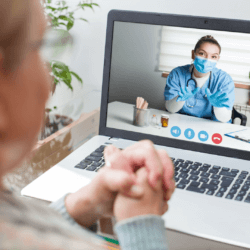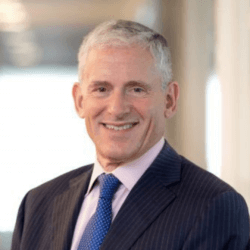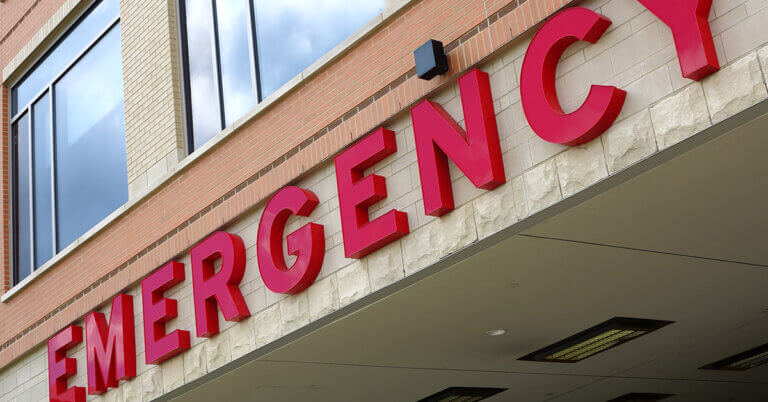December 21, 2020

The Worst and Best of Times: Perspectives from Cain Brothers’ Healthcare 2020 Virtual Conference
2020 has been a year like no other. Investors in U.S. healthcare have navigated remarkable economic and societal disruption by maintaining their focus on long-term value in healthcare businesses and sectors that solve undeniable problems.
At Cain Brothers’ 2020 Healthcare Virtual Conference, which ran from October 22-23, 2020, top private equity and venture investors discussed their outlooks and investment orientations going into another COVID winter. While somber about the pandemic’s societal and economic costs and cognizant of ongoing political uncertainty, panelists were both practical and optimistic as they surveyed the industry’s future.
Their confidence has reinforced and accelerated their longer-term investment strategies. The most attractive healthcare businesses for investors are scalable and asset light. They embrace payment risk, advance consumerism, and deploy technologies that improve efficiency, quality, engagement and costs.
Generally speaking, both private equity (PE) and venture capital investments currently center on companies that address chronic care, behavioral health and social determinants of health; accelerate pharmaceutical development; and/or improve the effectiveness of healthcare’s supply chain. The investment community’s willingness to pay premiums for such businesses is driving private and public market valuations to new heights.
While the pandemic hit providers hard, it also forced them to adapt and evolve in new and unprecedented ways. Out of necessity, providers have accelerated their adoption of tech-enabled services that promote access, enhance convenience, improve customer experience and lower costs. Other sectors, from pharma services to insurance, are responding similarly, pursuing business strategies that promote value, efficiency and reduced costs.
Collectively, these initiatives represent societal progress toward a better future – a healthcare industry more closely aligned with the needs of healthcare consumers, employers, and government.
The 2020 PE Two-Step
Cain Brothers’ Managing Director John Soden facilitated a panel of private equity investors [1] who offered insights into the current PE investor mindset. The panel included:
- John Maldonado, Managing Partner, Advent International [2]
- Julia Kahr, Senior Managing Director in the Private Equity Group at Blackstone [3]
- Ali Satvat, Partner and Co-Head of the Health Care industry team within KKR’s Americas Private Equity platform [4]
Their discussion reflected upon a year filled with surprises.
2020 began calmly enough at last January’s annual JP Morgan healthcare investor conference in San Francisco. Despite the early spread of COVID-19 in Asia, presenters from investment firms, sponsors and startups focused on business as usual. Discussion centered on high valuation multiples; the impressive volume of transaction activity over the past year; the appeal of consumer focused, asset-light, risk-embracing businesses; and some forward looks to the U.S. presidential election.
When COVID hit the U.S. in March, investor certainty and confidence dissolved. Deal flow slowed to a trickle as private equity and growth investors evaluated the pandemic’s impact on their portfolio companies and made tactical adjustments.

As Ali Satvat of KKR noted, “The first two quarters of the year was [sic] spent looking at our portfolio. What and where are the COVID implications?” John Maldonado of Advent International described how his firm took a “war room” approach as they examined the implications. “What is the impact of COVID going to be? What will be the hit to cash flow? What will leverage multiples look like? How are we going to get through this?”
Some portfolio companies put the brakes on their five-year plans. For others, the pandemic created opportunities to accelerate their market positioning.
As the economy re-opened through the summer, companies across healthcare adapted to COVID-driven operating realities. Revenues for health plans and at-risk providers showed strength as treatment payments diminished. Many experienced record profitability.
Non-hospital delivery models also thrived. Companies focused on telehealth, digital services, home health and hospice saw expansive demand growth for their services. Many investors concluded that COVID was accelerating the already-progressing transition to value-based care. It was time to play offense.
As Maldonado commented, “That’s when we flipped our war rooms to win rooms, and began to ask: How do we think about disproportionate share gain as the market comes back? How do we think about digital enablement? How do we shift from our back foot to our front foot?”
To general surprise, the expected hit to valuations never materialized and there was no sign of a “COVID discount.” Instead, deal flow picked up, as investors found opportunities across sectors. This included investing in companies operating in businesses once considered less attractive, such as healthcare supply chain.
The liquidity in the capital markets catalyzed significant deal-making. For example, on August 5, 2020, Teladoc and Livongo announced their merger plans. At the beginning of 2020, the two companies were worth a combined market valuation of $8B. By the time of the announcement, the new entity had a combined market capitalization of $37 billion.

Currently, Teladoc has a market capitalization of $28.5B with revenues of $867M. HCA has a market capitalization of $52B on revenues of $51B. Teladoc trades at 33 times revenue while HCA trades at approximately 1 times revenue. This disparity emphasizes the public market’s view of the growth potential of each company.
Discussing the increase in deal activity, Cain Brothers’ John Soden noted the flurry of SPACS, or Special Purpose Acquisition Companies, in funding transactions that might otherwise be natural for the IPO or private equity investor communities. As Soden observed, “There’s been more SPAC money raised year to date than in the previous 10 years combined.”
PE investors acknowledged the expansive number of SPACS interested in acquiring or investing in their portfolio companies. They cautioned, however, that potential SPAC investments must improve a business’ overall trajectory to merit serious consideration.
Shortly after the Cain Brothers’ conference Cano Health, a Miami-based operator of primary-care medical centers in Florida, Texas and Nevada, announced its sale to a SPAC for $4.4B. [5] Primarily serving seniors enrolled in Medicare Advantage, Cano’s enterprise value in the SPAC deal could be more than double what the company may have realized in a sale or recapitalization with private equity or public market IPO investors.
Commenting on these surprising market developments, the panel’s investors noted that their investment theses remained intact. “We still focus on the type of change,” Satvat emphasized. “Is it investable change or cataclysmic change?”
To date, neither COVID, nor its accompanying political turmoil, nor the SPAC boom have altered how PE investors approach exits. As Julia Kahr observed:
“An IPO is a point in time, multiple years down the line, and only one milestone. We’re looking at how sustainable the performance of the business is long-term, and what we can potentially do to
improve it. If we’ve got a company providing better quality care at lower cost with higher efficiency, on the right side of justice, and providing real value to the system, it’s going to be successful.”
Currently, PE investors prefer virtual and retail delivery models to those delivering facility-based services. As Satvat said, “We’re less interested in facility-based care than a model that could do both.” Amazon and Walmart serve as touchstones for how innovative consumer-driven companies balance online delivery channels with bricks-and-mortar.
Maldonado believes COVID has accelerated consumer acceptance of home-based care delivery. “We’re looking at which megatrends might be permanently inflected by COVID. It’s not just telehealth that people are willing to do at home now. They’re also willing to get their drugs at home and to get more healthcare at home.”
Venturing Forth
The venture panel [6] moderated by Cain Brothers’ Managing Director Jill Frew explored the unbundling of traditional hospital services as care moves to retail, community, home and virtual settings. Frew’s panel included the following participants:
- Ambar Bhattacharyya, Managing Director, Maverick Ventures [7]
- Nancy Brown, General Partner at Oak HC/FT [8]
- Marty Felsenthal, Partner, Health Velocity Capital [9]
The panelists agreed that the COVID-19 pandemic has accelerated service unbundling at a rate not seen since the passage of the Affordable Care Act in 2010. Telehealth is the poster child for this trend.

Marty Felsenthal described telehealth platforms generally as, “…healthcare without the bricks and mortar. In the same way that Amazon went from books and DVDs to everything, telehealth is moving into urgent care, virtual primary care, behavioral health care, and specialty areas ranging from dermatology to chronic and post-acute care management. This is healthcare’s online retail moment.”
Nancy Brown reflected on how big tech’s entry into healthcare is nothing new despite how difficult it is for companies from outside industries to successfully move the needle in healthcare. Healthcare has its own unique operating orientation that adapts to technological change more slowly than other industries. Disruption is harder.
Still, healthcare service delivery is changing. Brown highlighted the success of major retail players like Walmart and CVS in expanding access and transparency to care services, “Retailers are already established where consumers are living their lives, going shopping, doing the things they need to do, in locations that don’t have a lot of other access. They also represent brands consumers trust.”
Ambar Bhattacharyya questioned whether big tech had overlooked a major healthcare play at a critical juncture in 2020. “Apple, Google, Facebook, Microsoft, Walmart are all doing interesting things in healthcare. But I do think COVID was a once-in-a-generation missed opportunity for them, given people’s willingness to try new healthcare providers.”
Looking toward new models, Bhattacharyya suggested that established industry heavyweights, like United Health/Optum, will shape the industry’s future.
“Every board asks how Amazon will affect our business? The question should be what is United Health or Optum doing that will affect our business? They are setting themselves up to be a national health system, and a new form of competition for regional health systems and local providers with a more vertical full stack offering for insurance, virtual care, and in-person care. I think the real opportunity and risk for existing providers, is how do you stay one step ahead?”
Felsenthal fears that health systems will be tempted to use alternative delivery channels like telehealth and retail for steerage, merely to drive patients toward more expensive acute care. Long term, he believes such revenue-optimizing approaches will be counterproductive.
As Bhattacharyya put it:
“My hope is that [United / Optum] actually pushes innovation faster, and forces health systems not just to adopt the basics of technology but to go beyond and keep people out of hospitals in ways that would have been counter-intuitive a few years ago.”
Healthcare’s Convergent Future:
Less Transactional, More Personal, Digital & Virtual

Despite different areas of investment focus, venture and PE perspectives overlap considerably as they envision healthcare’s future. Their investments demonstrate a clear preference for asset-light, consumer-oriented and tech-enabled companies as well as business-to-business enterprises that serve providers, payers, pharma and med tech in creating value at lower costs.
Many of those investments focus on “platform” companies built to engage consumers more holistically and personally. As Nancy Brown emphasized, “We’re focused on sustainable relationships that are virtual first, and less transactional, bringing care to where people want to receive it. We want companies that solve undeniable problems.”
Scalable business models that solve Brown’s “undeniable problems” are most poised for grow. Such companies differentiate by offering products and services that address the unique needs of different types of consumers. Here are some examples.
Aging Seniors

America’s seniors have deep and unmet needs for better chronic care, support in sustaining independence, intensive memory care, hospice/end-of-life care, and social care addressing nutrition, transportation, physical well-being, accident prevention, and social isolation.
Increasingly, expansive primary and specialized care delivery companies are emerging to shift delivery channels and social supports away from high-cost centralized facilities to decentralized retail locations, home-based care and/or virtual sites. Leading businesses include at-risk service providers like ChenMed, Iora, VillageMD, Cano Health, Oak Street, and an array of home health and telehealth companies.
Gen Z and Millennials
Gen Z and Millennials see care delivery differently than previous generations. “When we think about telehealth, Gen Zs and Millennials just think about health,” Bhattacharyya stated. “They expect care offerings to be more like Netflix or Spotify– personal, on-demand, flawless, and with all the answers available.” Those consumers want tailored, technology-enabled, frictionless, 24/7 service offerings with transparent prices in all their market interactions.
Hims and Hers [10][11] exemplifies these type of new age companies. Started as a telehealth company focused on aesthetics, skin care and sexual health, Hims and Hers has quickly expanded into primary care and behavioral health with the support of external investors. In October, 2020, the company announced it was merging with a SPAC, Oaktree Acquistition Corp, at a total valuation of $1.6B12.
Niche Care
Advances in personalized medicine and technology make it increasingly possible to target niche care needs at scale. Felsenthal noted the tremendous opportunity for branded subspecialty care services. Brown emphasized that consumers need providers to proactively manage care needs, especially in distinct subpopulations, ranging from chronic diabetes to autoimmune disorders to women’s health.
Conclusion: Solving Undeniable Problems
As currently constituted, U.S. healthcare is fragmented and inefficient with significant care gaps that compromise individual and community health. The unmet needs of consumers represent the most undeniable healthcare problem of all.
Investors see opportunity in funding companies that meet those needs and address those gaps at scale through robust at-risk business models, efficient technology, cost-effective operations, and engaging service relationships. They are eager to pay for well-positioned companies with high growth potential.
Fortunately, the Post-COVID era shows every sign of being the dawn of a new age – one marked by better care, more engaged and personalized service, improved health outcomes and more cost-effective use of resources. With support by targeted venture and PE investment, American consumers and the American economy will be the ultimate winners.
(Access available through Cain Brothers staff. Email info@4sighthealth.com and we’ll connect you.)
Sources
- https://wsw.com/webcast/key12/panel5/ (Access available through Cain Brothers staff. Email info@4sighthealth.com and we’ll connect you.)
- https://www.adventinternational.com
- https://www.blackstone.com/our-businesses/private-equity/
- Health Care industry team within KKR’s Americas Private Equity platform
- https://www.reuters.com/article/cano-health-ma-jaws-acquisition/cano-health-to-list-via-4-4-bln-merger-with-barry-sternlicht-backed-spac-idUKL4N2HY38A
- https://wsw.com/webcast/key12/panel4/ (Access available through Cain Brothers staff. Email info@4sighthealth.com and we’ll connect you.)
- https://www.maverickventures.com
- Nancy Brown, General Partner at Oak HC/FT
- https://healthvelocitycapital.com
- https://www.forhims.com
- https://www.forhers.com
- https://www.fiercehealthcare.com/tech/digital-health-company-hims-hers-goes-public-blank-check-deal
Co-author
 Robert J. Fraiman, Jr. has been President of Cain Brothers, a division of KeyBanc Capital Markets, since 2010. As an investment banker with over 35 years’ experience, he has advised clients in mergers & acquisitions, debt and equity capital raising, and strategic growth initiatives. In addition to managing the Cain Brothers investment banking team, Mr. Fraiman has worked with clients in several hundred transformational transactions in healthcare services, providers, payers and medical technologies.
Robert J. Fraiman, Jr. has been President of Cain Brothers, a division of KeyBanc Capital Markets, since 2010. As an investment banker with over 35 years’ experience, he has advised clients in mergers & acquisitions, debt and equity capital raising, and strategic growth initiatives. In addition to managing the Cain Brothers investment banking team, Mr. Fraiman has worked with clients in several hundred transformational transactions in healthcare services, providers, payers and medical technologies.
Prior to joining Cain Brothers in 2004, Mr. Fraiman was head of healthcare investment banking at BMO Capital Markets. Mr. Fraiman began his investment banking career at Bear Stearns in 1985 and helped build that firm’s healthcare investment banking practice. From 1994 until his departure in 2001, as a Senior Managing Director at Bear Stearns, Mr. Fraiman worked with clients in the healthcare services and medical technology industries. Mr. Fraiman earned a BA in History from Colgate University and an MBA from Columbia Business School.





